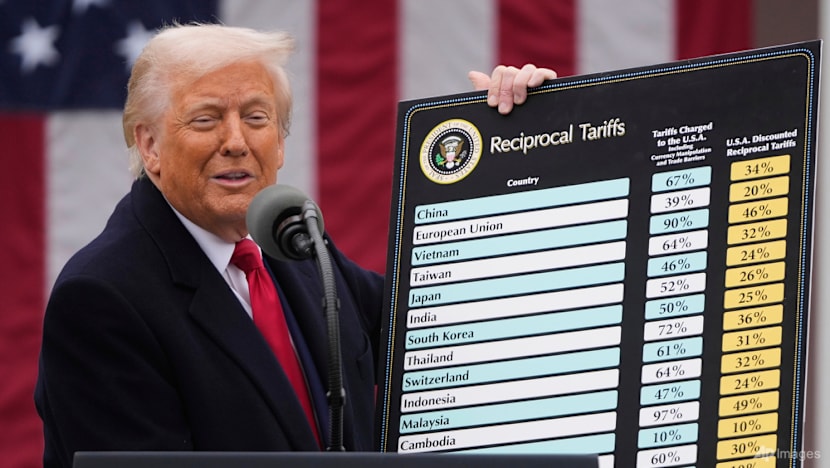Commentary: Southeast Asia has made the right moves in dealing with Trump
ASEAN countries have made wise strategic choices that helped build political goodwill in Washington, says political analyst Hasan Jafri.

President Donald Trump announces tariffs on Apr 2, 2025, in the Rose Garden at the White House in Washington. (AP Photo/Mark Schiefelbein, File)

This audio is generated by an AI tool.
SINGAPORE: It’s been six months since US President Donald Trump unveiled his Liberation Day tariffs that shocked the world. While risks of further damage to the global economy remain high, Southeast Asia has fared better than initial expectations, with most countries successfully securing lower tariffs than the rates announced on Apr 2.
Mr Trump has formally closed the chapter on decades of globalisation that lifted millions out of poverty and helped develop a globally integrated economy. He has not articulated its replacement.
Mr Trump isn’t the first American leader to drive the shift; former US presidents Barack Obama and Joe Biden were no cheerleaders for globalisation. While they may have used a scalpel to advance the US’ geoeconomic interests, Mr Trump prefers a chainsaw.
ENGAGING WASHINGTON HAS WORKED – FOR NOW
The world is now in a new era where trade dislocation, economic barriers and the cost of access to US consumers will be higher. It is still unclear what the final shape of this new order will be, but Southeast Asia has some agency and should position itself to take advantage.
As unpalatable as the Trump approach has been, Southeast Asian countries have made some wise strategic choices. These include negotiating bilaterally rather than acting as a bloc, and resisting political pressures at home.
The message Southeast Asian countries have sent is clear: The US matters to us and we are not a threat. We understand transactional relations and we know how to cut a deal. This has helped build political goodwill in Washington.
For now, the multi-pronged approach of negotiating for relief, and promising to buy more from America and to lower trade barriers has borne fruit. Not only has Mr Trump cut tariffs on most Southeast Asian countries since Liberation Day, he has kept tariffs on semiconductors and electronics off the table – at least for now. The respite gives the region comparative advantage over other countries like China and India and caps downside risks.
According to Maybank Research, Southeast Asia can benefit because American companies could potentially buy from the region rather than elsewhere, especially from Vietnam, Singapore, Thailand, Indonesia and Malaysia. Tariff exemptions for semiconductors are particularly important for Vietnam, Malaysia, Singapore and the Philippines where the sector accounts for a significant proportion of total exports to the US.
Despite dire predictions after the Liberation Day announcement, the region’s exports to the US have risen just as China’s have shrunk. That trend may change if the US and China conclude a deal and if US economic growth slows, but for now, comparative advantage has worked for Southeast Asia.
To protect their workers and industries, Southeast Asian countries have complemented international economic diplomacy with fiscal support. Singapore, Malaysia, Indonesia, Thailand and Vietnam have announced measures ranging from cash support to tax relief, cheaper credit and grants to buffer against potential damage. These will cost local taxpayers but may reap longer-term benefits.
Hence, Association of Southeast Asian Nations (ASEAN) countries are projected to grow by 4.6 per cent in 2025, according to research organisation AMRO. In August, Singapore updated its 2025 GDP growth forecast to 1.5 to 2.5 per cent, up from 0 to 2 per cent.
At the recent Milken Asia Summit, where global financiers met in Singapore, the focus was not doom-and-gloom but on how to invest and do more business in Southeast Asia.
As a US-based investor told me: “We are comfortable here (Southeast Asia) and so is Trump, which means we know it is safer to do business here, and the political risks are lower. This region knows how to get on with things. It’s so refreshing to be here.”
RISKS REMAIN BUT TIME TO CONSOLIDATE GAINS
It would be foolish to conclude that threats are now gone. Given that surprise is a major tool in how the Trump administration operates, the threat of new trade barriers remains a risk. Critical for the region are potential tariffs on electronics and semiconductor exports.
What also remains unresolved is the direction the US-China negotiations take and their impact. Mr Trump has threatened an additional 100 per cent tariffs if China does not remove its export restrictions on rare earth minerals. While a deal will help de-risk the global economy, what if it is one that reduces the comparative advantage that Southeast Asia currently enjoys?
That’s why it is important to nurture emerging green shoots even if the future economic order is not yet clear. One is a renewed global effort to diversify trade to reduce dependency on the US. In September, Indonesia signed trade deals with Canada and the European Union. Malaysia and the EU have resumed negotiations on a trade pact after a 12-year pause.
Vietnam, which already has a deal with Europe, is looking at other regions. Singapore, which has 28 free trade agreements, is also upgrading existing pacts and negotiating new ones. These measures, collectively, will help shape the new order.
While ASEAN is no EU, the Liberation Day shock should spur regional integration. Developing the ASEAN power grid, accelerating digitalisation and developing a green economy are all low-hanging fruits that can accelerate integration.
The overall political timing to press ahead with the US is also in ASEAN’s favour. If Mr Trump does visit Kuala Lumpur for the ASEAN Summit later this month – he may cancel at the last minute – ASEAN leaders will have his attention. A deal between Thailand and Cambodia – brokered by Washington – will make headlines. But beyond that, ASEAN nations can press for greater trade and economic relief.
With lavish praise, performative diplomacy and assurances that the region will continue to work with his administration, Mr Trump may just give Southeast Asian countries a better deal. If he shows up.
Hasan Jafri is a Singaporean analyst who advises clients on political and policy risk. He writes a monthly column for CNA, published every third Wednesday.


















